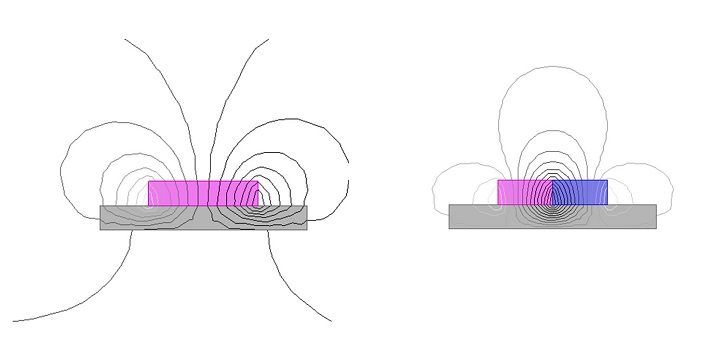قد يكون لدى العديد من العملاء سؤال: هل لدى مغناطيس نفس الأداء وحجم نفس قوة الشفط؟ يقال على الإنترنت أن قوة شفط المغناطيس NDFEB هي 640 ضعف وزنها. هل هذا موثوق؟
بادئ ذي بدء ، يجب توضيح أن المغناطيسات لديها فقط قوة امتصاص على المواد المغناطيسية. في درجة حرارة الغرفة ، لا يوجد سوى ثلاثة أنواع من المواد المغناطيسية المجهرية ، وهي الحديد ، والكوبالت ، والنيكل ، وسبائكهم. ليس لديهم قوة امتصاص على المواد غير المغناطيسية.
هناك أيضًا العديد من الصيغ على الإنترنت لحساب الشفط. قد لا تكون نتائج هذه الصيغ دقيقة ، لكن الاتجاه صحيح. ترتبط قوة الشفط المغناطيسي بقوة المجال المغناطيسي ومنطقة الامتزاز. كلما زادت قوة المجال المغناطيسي ، زادت مساحة الامتزاز وأكبر الشفط.
والسؤال التالي هو ، إذا كانت المغناطيس مسطحة أو أسطوانية أو ممدودة ، فهل سيكون لديهم نفس قوة الشفط؟ إذا لم يكن كذلك ، أي واحد لديه أعظم قوة شفط؟

بادئ ذي بدء ، من المؤكد أن قوة الشفط ليست هي نفسها. لتحديد أي قوة شفط هي الأعظم ، نحتاج إلى الإشارة إلى تعريف منتج الطاقة المغناطيسي القصوى. عندما تكون نقطة عمل المغناطيس بالقرب من الحد الأقصى للطاقة المغناطيسية ، يتمتع المغناطيس بأكبر طاقة عمل. قوة الامتزاز للمغناطيس هي أيضًا مظهر من مظاهر العمل ، وبالتالي فإن قوة الشفط المقابلة هي أيضًا الأعظم. تجدر الإشارة هنا إلى أن الكائن الذي سيتم امتصاصه يجب أن يكون كبيرًا بما يكفي لتغطية حجم القطب المغناطيسي بحيث يمكن تجاهل المادة والحجم والشكل وعوامل الكائن الأخرى المراد امتصاصها.
كيف تحكم على ما إذا كانت نقطة عمل المغناطيس هي في نقطة الحد الأقصى للمنتج للطاقة المغناطيسية؟ عندما يكون المغناطيس في حالة من الامتزاز المباشر مع امتصاص المواد ، يتم تحديد قوة الامتزاز الخاصة به بحجم المجال المغناطيسي للفجوة الهوائية ومنطقة الامتزاز.
أخذ المغناطيس الأسطواني على سبيل المثال ، عندما يكون H/D≈0.6 ، Center PC≈1 ، وعندما يكون بالقرب من نقطة عمل منتج الطاقة المغناطيسية القصوى ، تكون قوة الشفط هي الأكبر. وهذا يتماشى أيضًا مع القاعدة التي تفيد بأن المغناطيس عادة ما يتم تصميمه ليكون مسطحًا نسبيًا كامتصاص. أخذ المغناطيس N35 D10*6 مم على سبيل المثال ، من خلال محاكاة FEA ، يمكن حساب أن قوة شفط لوحة الحديد الممتز حوالي 27N ، والتي تصل تقريبًا إلى الحد الأقصى لقيمة المغناطيسات في نفس الحجم و 780 ضعفًا خاصًا بها وزن.
ما سبق هو فقط حالة الامتزاز لقطب واحد من المغناطيس. إذا كان مغنطة متعددة القطب ، فستكون قوة الشفط مختلفة تمامًا. ستكون قوة شفط المغنطة متعددة الأقطاب أكبر بكثير من قوة المغنطة أحادية القطب (تحت فرضية مسافة صغيرة من الكائن الممتز).

لماذا تتغير قوة شفط مغناطيس من نفس الحجم كثيرًا بعد أن تمغطيتها مع أعمدة متعددة؟ والسبب هو أن منطقة الامتزاز S تظل دون تغيير ، في حين أن قيمة كثافة التدفق المغناطيسي B من خلال الكائن الممتز تزيد كثيرًا. من مخطط خط القوة المغناطيسية أدناه ، يمكن ملاحظة أن كثافة خطوط القوة المغناطيسية التي تمر عبر ورقة حديدية للمغناطيس المغنطيسي متعدد القطب تزداد بشكل كبير. أخذ المغناطيس N35 D10*6MM كمثال ، يتم تحويله إلى مغنطة ثنائية القطب. تبلغ قوة الشفط لمحاكاة FEA التي تمتص الصفيحة الحديدية حوالي 1100 ضعف وزنها.

نظرًا لأن المغناطيس مصنوع في مغناطيس متعدد القطب ، فإن كل عمود يعادل مغناطيسًا أرق وأطول. يرتبط الحجم المحدد بالطريقة المغناطيسية متعددة الأقطاب وعدد الأعمدة.
حقوق النشر
@2024 Nanjing Huajin Magnet Co., Ltd. جميع الحقوق محفوظة
.
خريطة الموقع
/ المدونة
/ Xml
/ سياسة الخصوصية
 الشبكة المدعومة
الشبكة المدعومة
